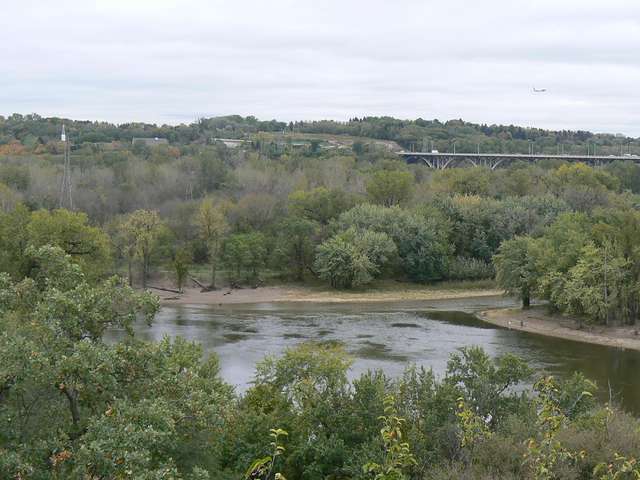St. Anthony Falls Lock could close within a year and it wont be too late!

Closing the Upper St. Anthony Falls Lock will protect upstream waters from invasive carp, while downstream tributaries like the Minnesota River are still vulnerable, leaving much work to be done to protect all of Minnesotas waters. Pictured here is the Minnesota River confluence with the Mississippi River near Fort Snelling.
Photo: Irene Jones
Last month, the U.S. House of Representatives joined the U.S. Senate in approving a bill that would close the Upper St. Anthony Falls Lock to protect the Mississippi River upstream of Minneapolis from invasive carp. Stopping invasive carp appears to be one issue that has near unanimous support among congressional reps, with the measure passing 417-3 in the House. Everyone in the Minnesota delegation backed the bill, with the exception of U.S. Rep. Collin Peterson.
Rep. Keith Ellison, who led the effort in the House, had this to say about the lock closure provision: The language included in this bill will make it harder for these non-native fish to spread to Northern Minnesota and provide protection for the recreational economy that is vital to our state. Minnesota faces many more threats from invasive species, and I hope this is the first of many bipartisan solutions that will preserve our natural resources.
Although the larger Water Resources Reform & Development Act (WRRDA) bills that contain this provision for lock closure need to be reconciled between the two houses of Congress, both bills include a trigger for lock closure based on annual tonnage of less than 1.5 million tons per year. The Upper Saint Anthony Lock has seen less than 1 million tons for the past few years, so the lock could be closed as early as the end of the 2014 navigation season.
In other news, there is some evidence that efforts to prevent invasive carp from invading the Minnesota, the St. Croix Rivers and other southern Minnesota tributaries may be not be futile after all. According to a well-attended lecture by Dr. Duane Chapman of the U.S. Geological Survey Environmental Research Center in Columbia, Mo., there is reason to believe we still have time to prevent invasive carps advance up the Mississippi River. This is in part because the progress of these unwanted fish has been hampered by a variety of factors, such as the biological complexity of river systems, the presence of healthy native fish populations, and the distance between dams along the river. That does not mean Minnesota can relax its efforts, but rather that aggressive continuation of our efforts is essential and will not be in vain.
Dr. Chapman spoke about research efforts in Minnesota and elsewhere that will someday enable us to control invasive carp, as well as de-mystifying some of the common misconceptions about invasive carp, such as how quickly they have spread since they were first found in the wild. Most accounts talk about invasive carp entering the Mississippi around 20 years ago, when in fact they have been in the river since the early 1970s.
MinnPost reported on Chapmans talk, and a video of the presentation is available as part of the Moos Family Speaker Series on Water Resources, The Biology and Management of Asian Carp: Lessons for Minnesota, by Duane Chapman.
News about the passage of WRDA appeared in the Star Tribune and in a press release issued by Keith Ellisons office.